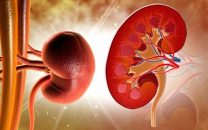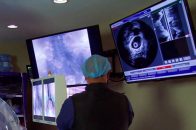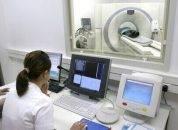In recent times, a lot has been said about reducing the duration or intensity of antiplatelet therapy following percutaneous coronary intervention (PCI) regardless initial indications. All evidence in support of these arguments might be failing to show the risk of non-culprit lesion events in patients with acute coronary syndromes (ACS). Potent and prolonged antithrombotic therapies…
A New Molecule to Prevent Contrast-Induced Kidney Injury
Administrating Recombinant Human C1-Esterase-Inhibitor (rhC1INH) before coronary angiography might mitigate contrast induced kidney injury. In addition, it shows a favorable safety profile in populations with multiple comorbidities. The contrast material used in all our diagnostic tests and therapeutic procedures causes tubular cytotoxicity and ischemia/reperfusion injury. rhC1INH had been effective at mitigating this mechanism in experimental…
ST-Segment Elevation Myocardial Infarction in the Time of COVID-19
This study cites the experience of 6 sites during the first month of the COVID-19 pandemic in New York. All patients included had a confirmed diagnosis of coronavirus infection and also ST-segment elevation on electrocardiography. Eighteen patients met these criteria. We are used to large randomized studies; consequently, this small registry of less than 20 people seems to…
Procedural Rescheduling Criteria in the Pandemic Era
Patients with structural heart disease are at higher risk in the face of the new coronavirus infection due to both advanced age and numerous comorbidities. All variables must be taken into account when deciding whether a patient can wait (so as to minimize the risk of exposure to the virus) or their pathology must be…
Reperfusion in the Time of COVID-19. What Has Changed?
We are living a pandemic due to the new COVID-19, but the world was already in the midst of a pandemic of cardiovascular disease. Both challenges defy healthcare systems worldwide, and the worst part is that they can coexist. Some symptoms for both diseases can overlap (such as respiratory distress) and they are unreliable, like…
Promising Outcomes of Transcatheter Mitral Valve Replacement in Complex Patients
Courtesy of Dr. Carlos Fava. The risk of repeat surgical mitral valve repair involves 6% to15% mortality at 30 days, even close to 20% in acute cases. However, mortality can rise to over 40% when it comes to a third or fourth surgical intervention. One of the solutions to this serious problem is transcatheter mitral…
IVUS in Left Main Coronary Artery Angioplasty: Luxury or Necessity?
Technique advancements in left main coronary artery angioplasty have turned this procedure into a reasonable alternative to surgery, particularly in patients with a low or intermediate Syntax score and, obviously, those in whom surgery was contraindicated. Results can be credited to a refinement in technique, better drug-eluting stents, better patient selection, and frequent use of…
Cardiology in Times of Coronavirus: The Perfect Storm
Since January 2020, the COVID-19 infection has spread from China to the rest of the world. The clinical picture has several points in common with influenza, being mild or asymptomatic in most cases. However, around 15% of cases shows complications with interstitial pneumonia that can lead to respiratory failure. Given the lack of vaccine or…
MR vs. FFR in Non-Culprit Lesions
Magnetic resonance (MR) and fractional flow reserve (FFR) correlate moderately as regards the assessment of non-culprit lesions in patients admitted with acute myocardial infarction who underwent primary angioplasty. For a similar degree of diagnostic accuracy, we would require a visual, semiquantitative, or fully quantitative comprehensive assessment of lesions. This work, soon to be published in…
Aortic Valvuloplasty as a Bridge to TAVR: Are We Wasting Our Time?
Doing a balloon aortic valvuloplasty can be a good way to “buy” time before a transcatheter aortic valve replacement (TAVR), according to a registry to be published this week in J Am Coll Cardiol Intv. This study analyzed the database of a whole country to find out the incidence, predictors and outcomes of balloon aortic…









